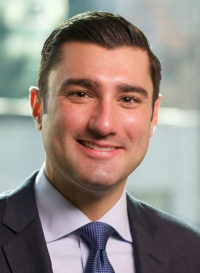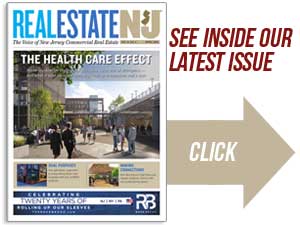The CityMD location in Clark opened late last year and is one of more than a dozen locations for the chain in New Jersey. — Courtesy: CityMD
By Joshua Burd
The Chiropractic Center and Morillo Eye Care have been mainstays at the Styertowne Shopping Center for more than 15 years, but they had been the lone medical tenants at the Clifton property.
That changed recently when a dentist and a physical therapy clinic opened in the complex, filling the spaces left by RadioShack and a shoe store.

For George Jacobs, it’s a sign of just how important the health care industry has become to his business.
“There’s a paucity of retailers out there — and you’ve got to fill space,” said Jacobs, president of Jacobs Enterprises Inc., which owns the shopping center at Route 3 and Bloomfield Avenue.
“It’s absolutely a trend in the business,” he added, pointing to the fact that medical users like visibility, parking and strong locations. “Retail tends to be the best of all of that.”
Medical tenants have become increasingly critical to the retail sector, creating a new opportunity for landlords who have grappled with e-commerce and bankrupt retail chains. New Jersey is no exception, and the opportunity comes as urgent care centers, physical therapists and other businesses experience rapid growth spurred by major changes in the health care industry.
Experts say there is more room to run, even as the retail market tightens in prime locations.
“They want to be in the shopping center environment,” said Neil Goldstein, co-founder and principal of The Goldstein Group, whose firm has completed several medical retail deals in recent years. “A lot of the medical people are moving that way these days. They don’t need to be in office buildings — or they don’t want to be.”

To be sure, many medical tenants now depend on the visibility of freestanding locations or in-line retail centers. Equally important are convenience and co-tenancy.
“These users all of a sudden are becoming more symbiotic with people’s day to day,” Andrea Kyriacou, a senior leasing representative with Levin Management Corp., said during a recent panel discussion hosted by Commercial Real Estate Women of New Jersey. “That’s particularly what we find with (physical therapy), because people will have to go three or four times a week.”
Experts point to the Affordable Care Act, also known as Obamacare, as the catalyst for the growth of urgent care centers and other medical retail tenants. The 2010 law greatly expanded the number of insured households in the U.S., allowing patients who previously sought care at the emergency room to instead visit general physician’s office and walk-in clinics.
“The caused a systemic and dramatic change in the medical industry,” said Jeffrey Otteau, president of Otteau Valuation Group in Matawan. “For one thing, we saw a growing need for general physicians and emergent care facilities because the patient population — the insured population — grew and there was a need to be able to accommodate this increased number of users and patients.”
That trend coincided with a growing number of hospital mergers and moves by larger systems to acquire physician practices and their medical office spaces, Otteau said. All of which coincided with the effects of the Great Recession, which meant that retail vacancy was higher and medical users could secure better deals.
The spread of medical tenants has been most visible among urgent care centers, which are retail settings that allow patients to walk in without appointments and avoid visiting the emergency room. With its large patient population, New Jersey is now home to dozens of retail locations for chains such as CityMD, MedExpress and AFC Urgent Care.

“We often reference the ‘toothbrush principle’ as a thesis to our site selection criteria,” said Dr. Nedal Shami, the chief growth officer for CityMD. “Where can we be visible and available to people twice a day? It’s important to be top of mind, to actively remind them that we are there and available should and when (we are) needed to deliver care.”
The New York-based provider has grown to 13 urgent care locations in the Garden State since fall 2015, when it opened its first New Jersey location in Paramus. Shami said two others are slated to open by year-end, while CityMD expects to have about 20 in the state by the end of 2019.
Nationwide, there were 7,639 urgent care centers in the U.S. as of June 2017, up from 7,271 in 2016 and 6,946 in 2015, according to the Urgent Care Association of America. The group also projected that the $18 billion industry would grow by 5.8 percent in 2018.
But retail owners and brokers say the industry extends well beyond urgent care. Physical therapy and dental practices are among those looking for retail space, along with pediatrics, dialysis clinics and eye care chains.
Bringing medical uses into a retail setting does come with challenges. Physicians, dentists and other health care tenants often require additional bathrooms, expanded utilities and larger water lines, which can eliminate older properties from consideration. Such users also come with heavy, complex equipment, all of which translates into a longer and costlier build-out and perhaps additional allowances for tenant improvements.
“The landlords have to be willing to partner to have a medical tenant, in most cases,” said Nancy Erickson, executive managing director with Colliers International, who moderated the CREW NJ panel discussion in late May.

What’s more, Erickson said a medical deal in an existing shopping center will typically require a use variance. That could add anywhere from six months to a year to completing a deal, she said, but brokers and landlords agree that it’s often worth the time and effort.
“Our goal is to produce cash flow,” said Jacobs, whose firm is based in Clifton. “And sometimes the choice comes down to a startup retailer versus an established doctor. Then you get into the question of: Is it a permitted use or not and who is the better risk?”
Jacobs added that, in his firm’s newer developments, medical is a permitted use from the start.
Because the spaces require a large investment and a complex build-out, health care users have typically sought longer terms, according to brokers and owners. Assuming the business remains viable, that has meant added stability for landlords who in past years were reluctant to do deals with medical tenants because there were no goods changing hands and no opportunity for percentage rent provisions.
Medical tenants have not only become an attractive option, but many have gained additional leverage as time has gone on. For instance, Kyriacou said “visibility is a very big factor now” for such users, whereas landlords in the past could push them to the periphery of the property. But urgent care centers and other health care tenants are now pushing for premium placement where they can maximize their façade and signage opportunities.
“They want end caps and freestanding, and there’s only so much of that to go around,” Kyriacou said. “So it does make it a little more difficult on our end.”

Erickson agreed that the medical users now see that they can operate from a position of strength.
“Medical tenants have become very confident and they feel their demands should be met,” Erickson said. “And they see that they’re the ones that are surviving when the market fluctuates.”

Otteau cautioned that the activity among medical retail users has slowed recently, in part because the retail market has improved since the trend began. Retail vacancy in northern New Jersey has decreased from 6 percent in 2010 to 4.6 percent today, he said, while rents have risen from about $20 to $22 per square foot.
“You could secure and lease retail space at a significant discount back when all of this began,” Otteau said. “That’s not the case today. Today, the retail market has corrected.”
He added that some types of medical users are still willing to consider both retail and office space.
That means they can now find better deals at office buildings in New Jersey, given that vacancy is higher than it is for retail space.
Sam Bernhaut, a broker and vice president with CBRE, echoed that belief during the recent CREW event.
“Office landlords are giving us tremendous incentives to come to their building,” said Bernhaut, whose clients include Riverside Medical Group and The Doctor’s Office Urgent Care. One recent offer included a year of free rent, $40 per square foot for tenant improvements and naming rights at an office building.
“So I would say it’s a good time to be a medical tenant in this market,” he added. “You do have a lot of options.”
Medical retail: What works and what doesn’t
As experts will tell you, many medical users still prefer office space over retail.
Chief among them are specialists such as cardiologists, surgeons and podiatrists that count on being close to hospitals and other clusters of medical services.
“They tend to group together with other specialists because there’s a lot of referral that goes on from one specialist to another,” Otteau said. “And they tend to locate in rings that surround large hospitals, because of the proximity to a lot of the diagnostic and testing equipment that are available in hospitals on an outpatient basis.”

Joe Lombardi, a medical and dental real estate consultant for Masserano Real Estate and Consulting, said referrals allow specialists to be far less dependent on being “in a location with retail characteristics.” They stand in contrast to general and primary care physicians “that appeal to a broader demographic and accept a wider range of payment types,” which make them a better fit for retail spaces. Pediatrics practices also serve as a good fit, Lombardi said.
“Pediatric services are a great tenant for a shopping center since they not only bring children, but parents and families as well,” he said. “They also serve as a great source of referrals for many other types of medical and dental services who will look to lease space at the center, too.”
Playing it safe
Legalized recreational marijuana is still nothing more than a proposal in New Jersey, even as supporters trumpet the economic benefits that would come from such a move.
Real estate owners are likely to be among the beneficiaries, including those who would be willing to open a dispensary within their retail centers. But as Kyriacou points out, not everyone is willing to take the risk, while some tenants are being proactive in their opposition to the concept.
“From a landlord’s perspective, I think it’s still something that people are very hesitant to allow into their centers,” Kyriacou said. “From the national tenants that we work with, they now put into their restrictions on the landlord that even if marijuana becomes legal, you still cannot permit that in your center.”










